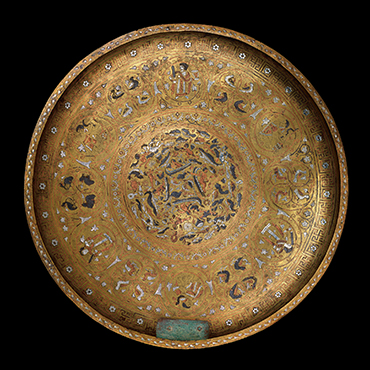A dish that celebrates the river Nile
As a uniquely surviving piece of luxury inlaid metalwork from the very beginning of the Islamic period, this dish demonstrates the continuity of Roman and Late Antique imagery. It may be the earliest known inlaid metalwork from the Islamic world, and given the combination of styles, it appears to have been produced under the Umayyads (AH 40–132/661–750 CE). This dynasty, based in Syria, was heavily influenced by the Roman and Byzantine heritage of the region. Combining it with Sasanian and other pre-Islamic artistic styles, they endeavored to create a distinctive iconography of their own. The decoration of this dish parallels the decorative elements seen in the Umayyad “desert castles”. The weight of the object suggests it was used for display in a courtly setting, rather than as practical tableware.
The four boats at the centre of the dish are very similar to those depicted on Roman and Byzantine silver vessels that represent the Nile. The inspiration for this design is confirmed by the plentiful fish, duck, crocodiles, and other animals that inhabit the roundel. No other vessel from the early Islamic period displays such complexity and variety of metal inlaid designs. Not only are the designs complex, but the different colors in the inlays are unprecedented in the Islamic world. Only one dish, discovered in Caesarea and dating from the 4th century pre-Islamic Byzantine period in Palestine, exhibits a comparable polychromy of inlaid figural designs, in this case using variously colored copper alloys. Copper inlay is known in a number of other vessels from the early Islamic period, but silver inlay is very rare. Scientific tests have determined the black inlay to be a non-magnetic form of iron which is completely unknown in any other Islamic vessel of any period.
Dish
Syria or Palestine, 1st–2nd century AH/7–8th century CE
Brass, copper, silver, and iron, h. 6.5 × diam. 55.4 cm
The Al Thani Collection, ATC635

